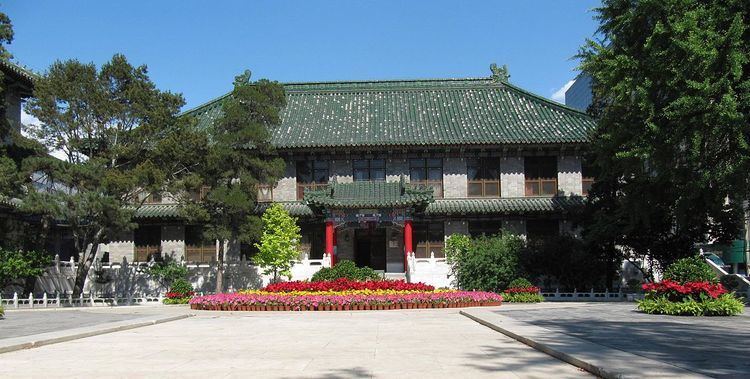President Cao Xuetao Campus Urban Founded 1917 | Established 1917 Phone +86 10 6513 5844 | |
 | ||
Address 9 Dongdan 3rd Alley, DongDan, Dongcheng Qu, Beijing Shi, China, 100005 Similar Capital Medical University, Peking University Health Sc, Beijing University of Chines, Tsinghua University, China Agricultural University | ||
Peking union medical college hospital
Peking Union Medical College (Chinese: 北京协和医学院) was founded in 1917 and is among the most selective medical colleges in the People's Republic of China, located in Beijing. The school is widely considered to be the best medical school in China and was ranked 1st in China by CUCAS in 2015. It is a relatively independent institution affiliated with Tsinghua University, one of the top two universities in China. Peking Union Medical College graduates receive Peking Union Medical College diploma signed by both the Peking Union Medical College and Tsinghua presidents. It is the only medical school in China to be affiliated with the Chinese Academy of Medical Sciences and the first medical school in China to introduce the 8 year M.D. program.
Contents
- Peking union medical college hospital
- Video of my trip to peking union medical college
- History
- Current status
- Research
- Hospitals
- Gallery
- References
The Hospital and College is located at No.9 Dongdan 3rd Alley, Dongcheng, Beijing, next to the Wangfujing shopping area.
Video of my trip to peking union medical college
History
The Peking Union Medical College Hospital was founded in 1906. The American Board of Commissioners for Foreign Missions, the Board of Foreign Missions of the Presbyterian Church in the U.S.A., the London Missionary Society, and later, the Board of Foreign Missions of the Methodist Episcopal Church, the Society for the Propagation of the Gospel, and the Medical Missionary Association of London, together with the then-Chinese government cooperated in the foundation and development of the Medical College and maintained it until 1915. The Rockefeller Foundation was established in 1913 and in 1913-1914 the newly formed Foundation created a Commission, including Dr. Franklin C. McLean, to examine medical education in China. One of its recommendations was that the Foundation - through a subsidiary organization - should assume financial responsibility for the College. On July 1, 1915 the recently established China Medical Board assumed full support of the Union Medical College, having previously acquired the property. The Commission's members had included both William Welch, the first Dean of the Johns Hopkins Medical School and Simon Flexner and the China Medical Board modeled the school after Johns Hopkins University School of Medicine following the recommendations of the Flexner Report which set the foundation of modern Medical Education in the United States and Canada. The PUMC was reorganized in 1917 and celebrated its 90th anniversary with a ceremony attended by the President of Johns Hopkins University, the Chair of the China Medical Board and representatives of the Rockefeller family and Rockefeller Brothers Fund.
In January of 1951, the new government nationalized PUMC, and the institution was accused of being an agent of American cultural imperialism. The Ministry of Health changed its name to China Union Medical College but did not radically alter the curriculum except to switch the language of instruction from English to Chinese. In 1952 the People's Liberation Army took charge of operations and remained in charge until 1956. The curriculum was militarized and shortened to one year in order to train army medical officers, and Soviet models introduced. The basic orientation to Western medicine was maintained and the staff continued to do research and advanced surgeries.
In 1956, autonomy was restored, but the college continued to be criticized for its elitism, cosmopolitanism, and failure to "serve the people" during periodic campaigns. During the Cultural Revolution, Peking Union Medical College was closed. In 1979, it reopened as the "Capital University of Medical Sciences" then returned to Peking Union Medical College (协和医科大学) in 1985.
Current status
Peking Union Medical College students traditionally attend Peking University biology department for their pre-meds portion of education. Since 2006, Tsinghua University has been holding a joint MD program in clinical medical science. Enrollment of the clinical medical science at PUMC is based on individual's performance in high school and the score of National Exam at the graduation. The curriculum of clinical medical science is 8 years, accepts about 90 students each year and includes 2.5 years of pre-medical education in the School of Life Sciences at Tsinghua University, the students have their pre-med studies at Tsinghua University are considered as the students of both PUMC and Tsinghua University. The college also has its independent Graduate School which recruits from other medical schools around country. The health care services at Peking Union Medical College Hospital are widely believed in mainland China to be among the most technically advanced. Many prominent political and social leaders in China have sought medical treatment at the PUMC Hospital.
Peking Union Medical College has provided generations of leaders for academic and clinical medicine and related areas all over the world. Peking Union Medical College describes itself as an official college of Tsinghua University, and advises students to state "Tsinghua University, Peking Union Medical College" on résumés.
Peking Union Medical College is part of the Project 211 list of universities receiving national funding.
Research
The medical school is the home to 4 state key labs and 6 WHO collaborating centers including the:
